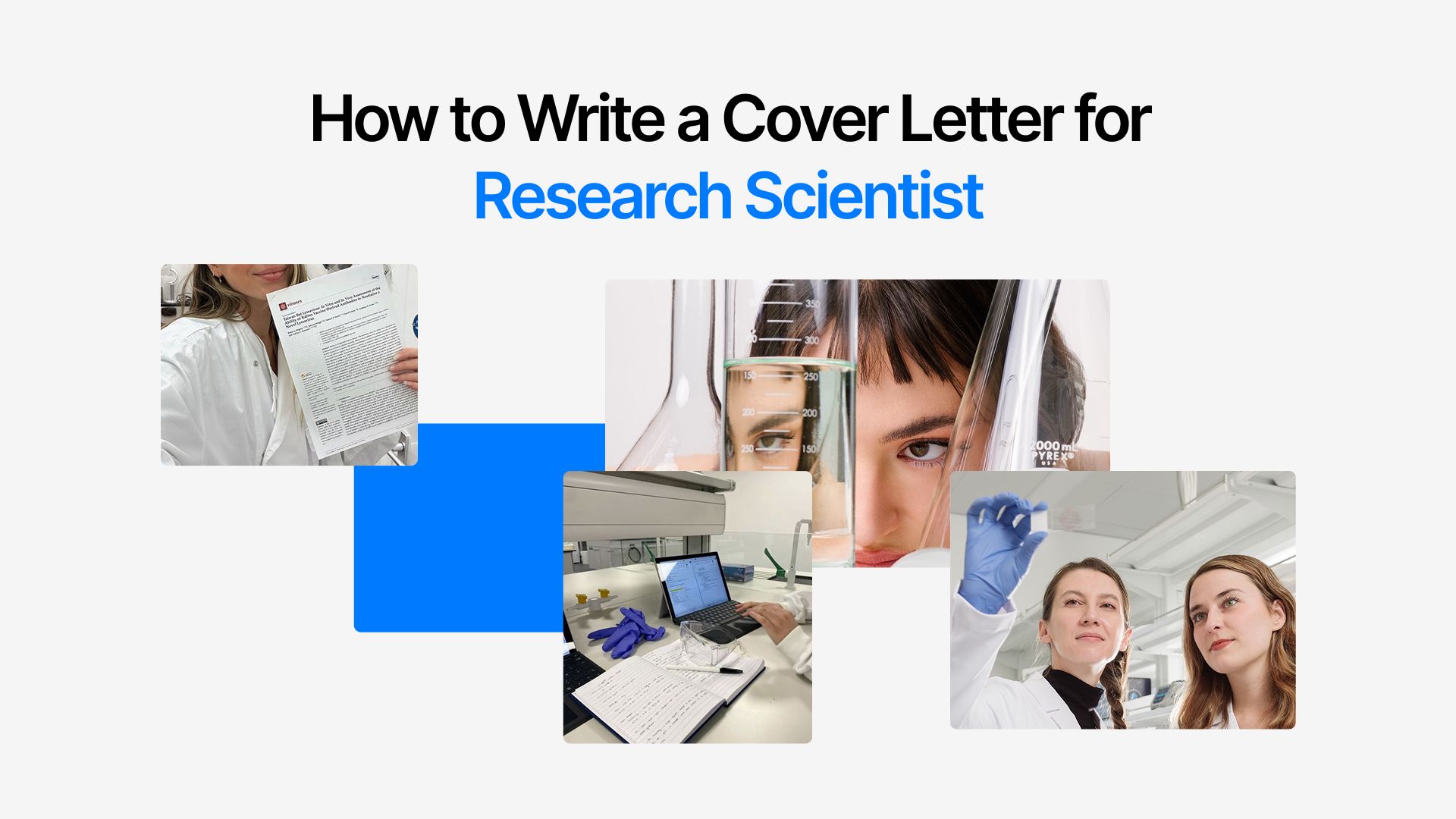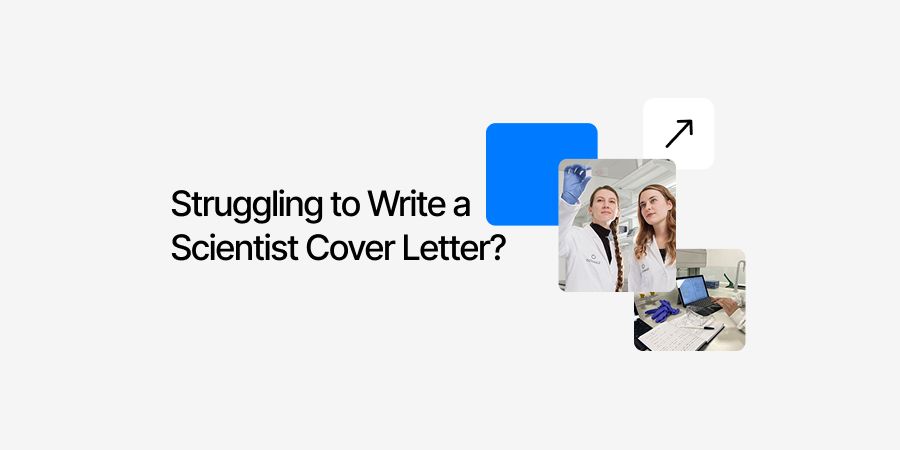
How to Write a Cover Letter for Research Scientist
A cover letter for a research scientist position is not a formality as in many other jobs.
Today, research organizations see it as the first signal to the hiring committee that you understand their work and can add value. A well-written cover letter shows scientific credibility, communication skill, and awareness of the institution’s mission.
Let’s understand this in detail.
Understanding the Role of a Research Scientist Cover Letter
A research scientist cover letter is different from a typical job letter. It must show intellectual depth and alignment with ongoing projects. Employers and principal investigators want to see more than skills.
They want evidence that you understand their lab or research program. The cover letter becomes proof that you can explain your expertise clearly, a skill that matters in grant proposals, papers, and presentations.
A strong letter does three things:
-
Links your background with the lab’s or company’s goals.
-
Proves you can communicate science with clarity.
-
Highlights achievements without overwhelming jargon.
Preparing Before You Write a Cover Letter
Preparation shapes the quality of your cover letter. A generic approach will always look weak compared to a tailored one.
Begin with careful research on the institution and role.
Research the Institution and Lab
Read recent publications from the lab or company. Identify principal investigators or project leads. Note if they have grants, partnerships, or collaborations. A good letter shows that you know their work and are eager to contribute.
Identify What They Value Most
Some institutions prioritize basic science. Others want translational research or industry application. Your examples should reflect their priorities.
Match Your Skills to Their Mission
Make a list of your research skills, methods, and areas of specialization. Then, connect each to the role. For example, if the lab is focused on genomics, highlight sequencing and bioinformatics experience. If it is in applied AI for healthcare, emphasize cross-domain work.
Pointers to remember:
-
Collect 2–3 publications of the lab and refer to them indirectly.
-
Prepare a brief list of your own relevant achievements.
-
Note transferable skills: collaboration, grant writing, technical reporting.
Structuring the Research Scientist Cover Letter
The structure of a cover letter is simple, but its strength lies in execution. Each part serves a purpose and together they create a narrative that convinces the reader.
Heading and Contact Information
Start with your full name, address, phone number, and email. Follow this with the date and the recipient’s details. Keep it professional and avoid decorative elements.
Example:
Dr. Emily Johnson
12 Green Street
Sydney, NSW 2000
emily.johnson@email.com
+61 400 123 456
15 October 2025
Professor Mark Spencer
School of Biomedical Sciences
University of Melbourne
This format makes your application clear and credible from the first glance.
Opening Paragraph That Grabs Attention
The first paragraph must establish interest and credibility. Mention the role you are applying for and where you found it. Then, state one reason why you are excited about their research area.
A good opening balances professionalism and enthusiasm:
“I am writing to apply for the Research Scientist position at the University of Melbourne, focusing on molecular oncology. Your recent work on cancer signaling pathways has inspired me to contribute my experience in protein analysis and translational research.”
Middle Section That Proves Fit
The body of the cover letter is where you connect your skills with the lab’s goals. Instead of listing every qualification, highlight a few strong points. Support them with evidence.
Use a simple three-part structure:
-
State your achievement: e.g., published in Nature Genetics.
-
Explain its relevance: how it links to their research.
-
Show the outcome: impact on the field or project success.
Example: “In my PhD work at Monash University, I optimized CRISPR-based techniques to study gene regulation. This experience will contribute directly to your team’s work on targeted therapies, especially where precision and reproducibility are essential.”
Closing That Reinforces Commitment
The conclusion should not be generic. Reinforce your enthusiasm and suggest readiness to discuss your work further. Avoid clichés like “thank you for your time.” Instead, make it forward-looking.
Example: “I would welcome the opportunity to discuss how my background in molecular biology and collaborative research could support your lab’s goals. I am particularly eager to contribute to your ongoing studies on translational applications of cancer biology.”
Best Practices for Writing a Research Scientist Cover Letter
A research-focused cover letter has to blend technical expertise with personal clarity. Employers want to see skill, but also confidence in communication.
-
Tailor to the institution – Mention the lab, university, or company by name. Show familiarity with their research focus or published work.
-
Quantify achievements – Use numbers where possible. Cite how many publications, projects completed, or grants secured.
-
Highlight collaboration – Stress team projects, co-authored papers, and interdisciplinary work. Science is never solo.
-
Emphasize technical expertise – Be specific about methods, software, or lab techniques you mastered.
-
Balance tone – Keep it formal but not stiff. A cover letter should be read naturally, not as an abstract.
This structured approach helps the letter rank well when employers search for research-specific applications.
It also satisfies ATS (Applicant Tracking Systems) that often scan for relevant keywords like grant writing, molecular analysis, or clinical trials.
Common Mistakes in Research Scientist Cover Letters
Many strong candidates weaken their application with errors that are easy to avoid.
-
Writing generic letters without referencing the lab or role.
-
Overloading the letter with every publication or technical term.
-
Making the tone too dry, like a research paper.
-
Forgetting to explain why their research matters to the hiring lab.
-
Missing basic details like correct spelling of the professor’s name.
A mistake at this stage can overshadow even the strongest resume. Clarity and personalization carry weight.
Example of a Strong Cover Letter for Research Scientist
Here’s a brief example that shows how everything fits together.
“I am applying for the Research Scientist role at the Garvan Institute of Medical Research. My recent postdoctoral work focused on computational biology, where I developed algorithms to analyze genomic data sets with over 10 million entries. This work has been published in Genome Biology and cited more than 250 times. I believe my background in data-driven research and my experience leading cross-functional projects can directly support your ongoing work in cancer genomics.”
Notice how the example stays short, factual, and impactful, with keywords like genomic data, computational biology, and cancer genomics naturally fitting into the text.
Tailoring a Cover Letter for Academia vs Industry
The focus of a cover letter changes with the setting. Academic posts often value publications and teaching potential. Industry roles usually lean more on practical impact and teamwork.
Academic Research Roles
When applying for a university or research institute position, highlight your scholarly track. Mention:
-
Peer-reviewed publications and the journals they appeared in.
-
Conferences where you presented your work.
-
Grants or fellowships secured and how they supported research.
-
Teaching or mentoring experience with students or junior researchers.
This shows not only your research record but also your role in building knowledge for the institution.
Industry Research Positions
Private sector labs or biotech firms want proof that your skills solve problems and lead to results. Emphasize:
-
Applied projects with measurable outcomes.
-
Team collaborations across functions like engineering or data science.
-
Experience working under deadlines or product cycles.
-
Ability to translate research into tangible solutions.
The structure stays similar, but the narrative shifts from academic prestige to real-world application.
How Chatly Can Help Write a Strong Research Scientist Cover Letter
Writing a letter that balances precision with personality can feel challenging. This is where Chatly with AI Chat and AI Search and AI Image Generation becomes a supportive tool.
Chatly can:
-
Generate a polished draft based on your CV and job posting.
-
Suggest stronger phrasing for technical terms to make them recruiter-friendly.
-
Restructure your content so achievements stand out without overwhelming detail.
-
Provide sample openings and closings tailored to academic or industry roles.
-
Help refine tone so your letter feels professional yet approachable.
Instead of spending hours revising sentences, you focus on research while Chatly organizes and sharpens your letter.
The outcome is a version that reads clearly, includes the right keywords, and fits the expectations of both academics and employers.
Wrapping Up
A strong cover letter for a research scientist position does more than list achievements. It tells a story that links your background to the needs of the lab or company.
Structure matters, but clarity and context carry equal weight. Mention your most relevant skills, explain their impact, and close with confidence.
This is not about repeating your resume but shaping it into a message that proves fit.
Cover letters in research remain highly competitive, and every word counts. The right balance of academic rigor and professional tone can be the factor that moves your application forward.
Suggested Reads for Further Guidance
Each of these provides insights into structured writing, professional tone, and context building.
Frequently Asked Questions
Most asked questions for writing a cover letter for a research scientist.
More topics you may like

11 Best ChatGPT Alternatives (Free & Paid) to Try in 2025 – Compare Top AI Chat Tools

Muhammad Bin Habib

24/7 Customer Support with AI Chat: Benefits, Examples and More

Muhammad Bin Habib

28 Best AI Tools for Students in 2025 – The Complete AI-Powered Academic Success Guide

Muhammad Bin Habib

How to Effectively Plan Travel Itineraries: Complete Guide

Muhammad Bin Habib

How to Generate an Essay Outline in Minutes

Muhammad Bin Habib
